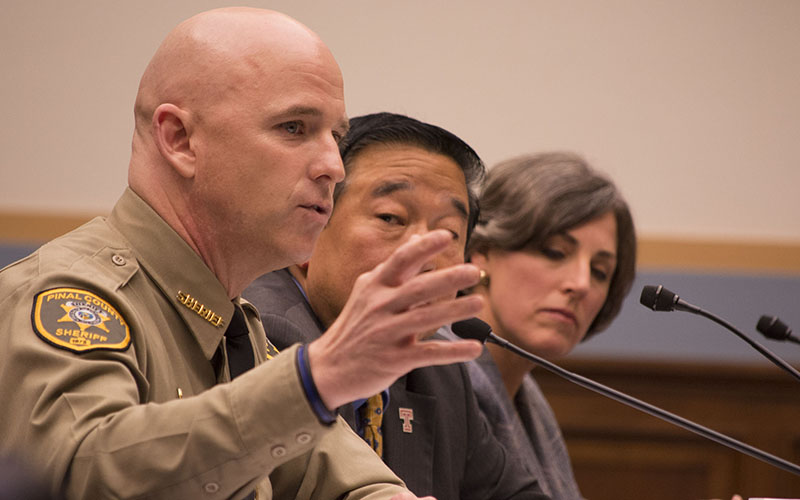
Pinal County Sheriff Paul Babeu, here testifying before a House committee this spring. Babeu is the latest Republican to announce a bid for the open 1st District congressional seat, which has drawn five GOP hopefuls with more than a year before the election. (Photo by Kristen Hwang/Cronkite News)
WASHINGTON – The Republican primary field in the race for Arizona’s 1st Congressional District got more crowded Monday, setting the stage for a competitive GOP primary reminiscent of the bruising 2012 campaign for the same seat.
State House Speaker David Gowan and Pinal County Sheriff Paul Babeu threw their hats in the ring Monday, joining former Secretary of State Ken Bennett, rancher Gary Kiehne and Navajo businessman Shawn Redd in the field.
Those five are competing for the right to run in a general election that so far has only one name Democrat, former Republican state legislator Tom O’Halleran.
But Republicans Monday were welcoming the primary fight.
“Republican primaries tend to be fierce,” said former State House Speaker Andy Tobin, who ran for the 1st District seat in 2014. “Everybody’s got a different viewpoint.”
Tobin beat out Kiehne and Adam Kwasman in a heated primary last year – a battle that some said contributed to his general election loss to incumbent Rep. Ann Kirkpatrick, D-Flagstaff, who faced no opposition in the Democratic primary.
But Tobin said the competition is healthy for the Republican Party because it offers more viewpoints for the public to consider.
“More candidates means more debate,” Tobin said, which is why “we turn out better candidates.”
That was echoed by Arizona Republican Party spokesman Tim Sifert.
“That passes for conventional wisdom,” Sifert said of the argument that a strenuous primary splits party votes and drains campaign resources for the general election. “But I think it bodes well for Republicans.”
Kirkpatrick announced in May that she will challenge Sen. John McCain, R-Arizona, for his Senate seat next year, leaving her House seat up for grabs.
“Anytime there’s an open seat in a swing district, Republicans really try to get in there,” said Sifert.
This is not the first time Republicans have seen a big field in the 1st District. Besides the three who ran in the 2014 primary, four competed in 2012.
Sifert pointed to last year’s gubernatorial race as an example of how crowded primaries don’t always end in defeat. Gov. Doug Ducey emerged from a field of six GOP candidates in what Sifert called “a knock-down, drag-out fight,” and went on to defeat Democrat Fred DuVal in the general election.
“A crowded and contested primary isn’t as bad as some people think,” Sifert said.
But while it may not be as bad, it can still be expensive, said Barbara Lubin, a spokeswoman for Arizona’s Democratic Party.
“A crowded field will make them (candidates) have to spend more money,” said Lubin, who listed cost as a reason Democrats have taken a different approach in the state’s 1st District.
But Lubin said the lack of primary challengers so far isn’t a strategy and doesn’t give Democrats any advantage over Republican candidates.
“There’s not a good or a bad way to do primaries,” she said.
Arizona’s 1st District includes parts of Tucson, Flagstaff and the Navajo Reservation and is the state’s biggest congressional district.
It’s also coveted by both parties, according to Babeu.
“For Republicans, this district is a pickup,” he said.
Babeu said it’s “too early to tell” how the race will go because his competitors are already “too many to count.” But he said he’s expecting it to be a fierce competition.
“In fact, I’m counting on it,” Babeu said. “My county represents a third of the district … I will not be outhustled.”
Calls Monday to other GOP candidates in the 1st District race were not immediately returned.